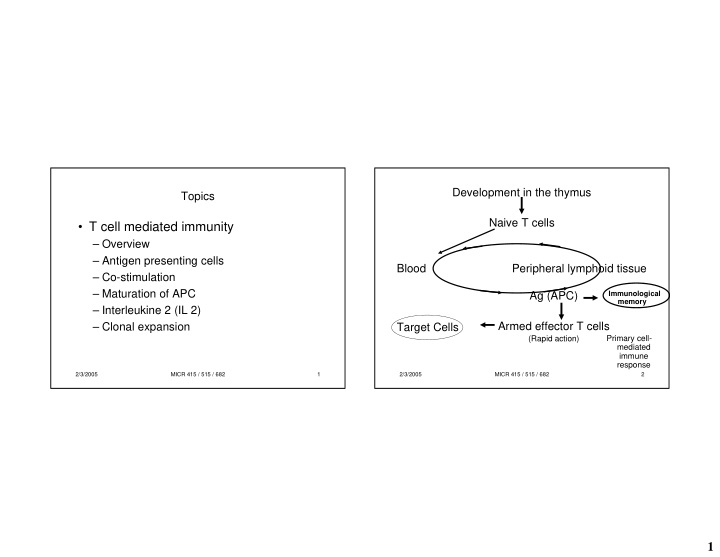



Development in the thymus Topics Naive T cells • T cell mediated immunity – Overview – Antigen presenting cells Blood Peripheral lymphoid tissue – Co-stimulation – Maturation of APC Immunological Ag (APC) memory – Interleukine 2 (IL 2) Armed effector T cells – Clonal expansion Target Cells (Rapid action) Primary cell- mediated immune response 2/3/2005 MICR 415 / 515 / 682 1 2/3/2005 MICR 415 / 515 / 682 2 1
Pathogen products are transported to peripheral Cell – Cell interactions in the Lymph Node lymphoid tissues Ag T cells monitor APC T cells enter lymph node • Peripheral sites to draining lymph nodes Fig 8.2 • Blood to Spleen • Mucosal surfaces to Peye’s Patches (MALT) If no interaction, T cells leave If interaction, T cells proliferate • T cells Enter via High endothelial venules and differentiate • Have contact with APC (Sample MHC) • Receive survival signals • If not activated they exit back into circulation 2/3/2005 MICR 415 / 515 / 682 3 2/3/2005 MICR 415 / 515 / 682 4 2
Types of T cells • Helper T lymphocytes • Cytotoxic T (T helper cells) lymphocytes Macrophages Dendritic Cells – CD4+ • Scavengers – innate immune • Immature cells reside in the – CD8+ response – TCR recognizes tissues i.e Langerhans’ ( low • Can present antigens in – TCR recognizes MHC expression, high • MHC II MHC I and II and provide phagocytic activity) • MHC I co-stimulation when • exogenous peptide • Upon activation by infection activated • endogenous peptide they migrate to lymphoid – Production of cytokines organs (high MHC – Killing of self cells – Activation of B cells expression, no phagocytic macrophages activity) • infected with virus • Bind to pathogens through surface – Immune response receptors • tumor cells • Display peptides in MHC II regulation • Express co-stimulatory molecules in Antigen Presenting Fig 8.3 response to stimuli by infection or cells cytokines 2/3/2005 MICR 415 / 515 / 682 5 2/3/2005 MICR 415 / 515 / 682 6 3
Cell adhesion Cell adhesion molecules stabilize molecules stabilize cell- cell-cell interactions cell interactions INTEGRINS SELECTINS Leukocyte homing Leukocyte homing & Cell activation Fig 8.4 2/3/2005 MICR 415 / 515 / 682 7 2/3/2005 MICR 415 / 515 / 682 8 4
Priming Adhesion molecules stabilize cell-cell Co-stimulation interactions 2/3/2005 MICR 415 / 515 / 682 9 2/3/2005 MICR 415 / 515 / 682 10 5
Co-stimulation Co-stimulation Fig 8.12 2/3/2005 MICR 415 / 515 / 682 11 2/3/2005 MICR 415 / 515 / 682 12 6
Activation only by professional APC Improper Co-stimulation Activated Anergy Fig 8.13 2/3/2005 MICR 415 / 515 / 682 13 2/3/2005 MICR 415 / 515 / 682 14 7
Maturation of Dendritic cells 2/3/2005 MICR 415 / 515 / 682 15 2/3/2005 MICR 415 / 515 / 682 16 Fig 8.14 8
9 18 MICR 415 / 515 / 682 2/3/2005 17 MICR 415 / 515 / 682 2/3/2005
B cell Ag presentation 2/3/2005 MICR 415 / 515 / 682 19 2/3/2005 MICR 415 / 515 / 682 20 10
High affinity IL-2 receptor – Naïve T cells are small resting cells that have long lives – Infrequent divisions – Infrequent apoptosis – Upon activation, T cells enter cell cycle, divide and proliferate – Process mediated by IL-2 2/3/2005 MICR 415 / 515 / 682 21 2/3/2005 MICR 415 / 515 / 682 22 11
Co-stimulation leads to IL-2 expression Clonal expansion Low affinity IL-2 receptor IL-2 Naive T cells Activated T cells High affinity –No need for co-stimulation IL-2 receptor Fig 8.22 2/3/2005 MICR 415 / 515 / 682 23 2/3/2005 MICR 415 / 515 / 682 24 12
Cell-surface Molecule expression changes with activation of T cell 2/3/2005 MICR 415 / 515 / 682 25 13
Recommend
More recommend